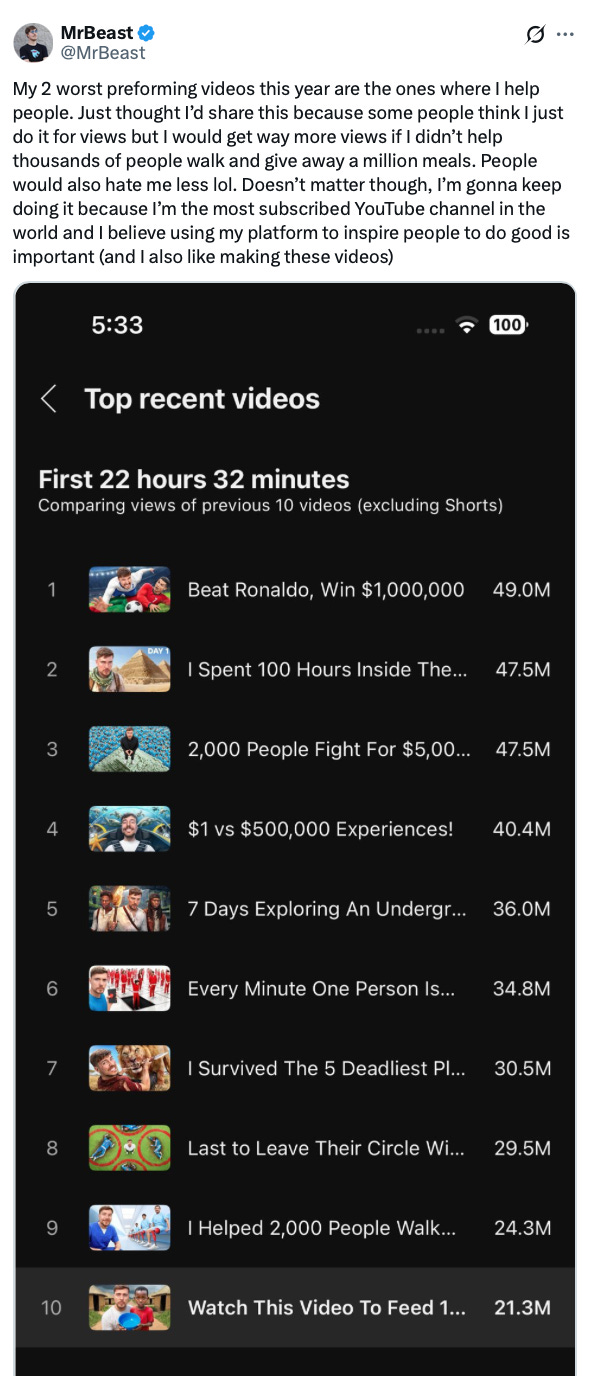The Next Generation of Givers Will Be a Beast
In the world of charitable giving, the donors are younger and the dollars are louder.
Whaddup y'all — I'm Quinten, a senior director of content at Artemis Ward. Welcome to my column, where I get lost online and return with a new way of understanding what’s going on in the world around us. This week's topic: charitable giving.
Under the word “BEFORE,” a boy wears a dirty white polo. Strapped to his back is a handmade knapsack overflowing with clay bricks. Under the word “AFTER,” he sports a blue sweater vest, a red necktie and a matching bright red backpack. He’s in front of a chalkboard, on which someone — perhaps the boy? — has been working through some geometry, maybe trigonometry. The subtext, if you could call it that, is clear. Thanks to the smiling, blue-eyed man with the scruffy goatee in the center of the frame, the boy’s life has been changed for the better.
This is the thumbnail for “Rescuing Child Slaves in Africa,” a video uploaded to the YouTube channel Beast Philanthropy on April 6. Over the course of a brisk five minutes and twenty-five seconds, MrBeast — a thirty-something mega-philanthropist whose real name is Jimmy Donaldson — recounts his partnership with Ghana Make a Difference, an organization that provides shelter, education, and medical care to children who have been enslaved, endangered, or abandoned. It’s an incredibly effective video, compelling enough to make even the most cold-hearted cynic see how genuine and impactful Donaldson’s efforts are.
Often seen sporting a graphic tee and oversized straw hat, MrBeast doesn’t look like your typical philanthropist. If you, or more likely your children, are familiar with his work, it’s likely for the elaborate stunts he shares on his main account. With titles like “Would You Risk Drowning for $500,000” and “I Spent 7 Days in Solitary Confinement,” Donaldson’s videos ruthlessly exploit human psychology to generate tens of billions of views.
But look beyond the eccentricities and the (sometimes polarizing) social media antics, and what you see is a portrait of the philanthropy’s next generation. That is: an ambitious twenty-something entrepreneur and businessperson with an instinctive sense of how to activate the contemporary media landscape, a bucketful of causes that he’s eager to champion, and more money than he knows what to do with. (In the name of “making kindness viral,” Beast Philanthropy has donated more than 50 million pounds of food, delivered more than 41 million meals, and fed more than 7 million people worldwide.)
MrBeast represents a new generation of philanthropists that wields an incredible amount of economic power. Beyond simply writing checks, they:
Tell big, bold stories that break through the noise
Support timely, relevant, of-the-moment issues, which aren’t necessarily the perennial causes we’re used to seeing in the philanthropic world
Confront those issues with a healthy mix of head and heart — and reality and imagination
Communicate demonstrable impact that extends beyond dollars spent and into actions taken (Does it get more direct than 50 million pounds of food?)
These characteristics suggest that, unlike previous generations, this rising cohort of philanthropists are less interested in cachet, and more interested in creating “viral” moments out of charitable giving. For example, this past month, the first recipient of TikTok star Alix Earle’s scholarship graduated from The University of Miami — with a People Magazine feature to boot. And in March, the YouTube the Sidemen drew 90,000 fans to Wembley Stadium for a YouTube-chronicled sixth edition of their Sidemen Charity Match.
It’s through this lens that we can better understand the next generation of mega-donors’ approach to giving. Is it sometimes crass, occasionally self-serving, and in its worst moments manipulative? Maybe. But it’s also direct, quantifiable, and issues-driven. And as today’s nonprofits build relationships with these donors, they need to navigate those complex (if not somewhat hypocritical) set of values.
The So What
MrBeast, and donors like him, represent an inflection point facing today’s nonprofits. In a changing fundraising landscape, it is no longer enough to appeal to legacy or tradition. To remain relevant, organizations need to consider engaging donors like MrBeast who value visibility and emotional impact — and want to be part of the story themselves.
As I wrote in my piece on fast food last month, it’s this dissonance — or even duplicity — that defines the society we’ve built for ourselves: simultaneously selfish and selfless, orthodox and irreverent, righteous and unequal. And if MrBeast teaches us anything, its that the people who thrive in this moment are the ones who embrace these tensions, not the ones who try and sidestep them.
✉️ If you haven’t yet subscribed, click the click below so you don’t miss a thing.




